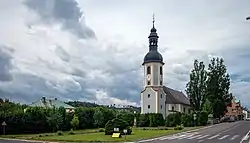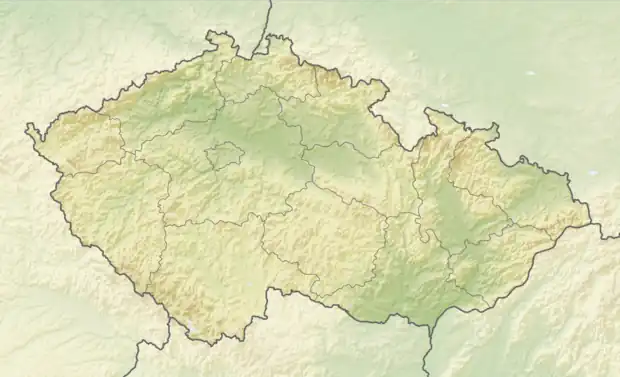Velký Šenov | |
|---|---|
 Church of Saint Bartholomew | |
 Flag  Coat of arms | |
 Velký Šenov Location in the Czech Republic | |
| Coordinates: 50°59′27″N 14°22′28″E / 50.99083°N 14.37444°E | |
| Country | |
| Region | Ústí nad Labem |
| District | Děčín |
| First mentioned | 1404 |
| Government | |
| • Mayor | Dušan Víta |
| Area | |
| • Total | 19.82 km2 (7.65 sq mi) |
| Elevation | 357 m (1,171 ft) |
| Population (2023-01-01)[1] | |
| • Total | 2,009 |
| • Density | 100/km2 (260/sq mi) |
| Time zone | UTC+1 (CET) |
| • Summer (DST) | UTC+2 (CEST) |
| Postal code | 407 78 |
| Website | www |
Velký Šenov (German: Groß Schönau) is a town in Děčín District in the Ústí nad Labem Region of the Czech Republic. It has about 2,000 inhabitants.
Administrative parts
The villages of Janovka, Knížecí, Leopoldka, Malý Šenov and Staré Hraběcí are administrative parts of Velký Šenov.
Geography
Velký Šenov is located about 26 kilometres (16 mi) northeast of Děčín. It is located in the salient region of Šluknov Hook on the border with Germany. It lies in the Lusatian Highlands. The highest point is the Hrazený mountain at 610 m (2,000 ft) above sea level. The Sebnitz River (here called Vilémovský potok) originates in the woods in the southeastern part of the municipal territory and flows through the town proper.
History
The first written mention of Šenov is from 1404. There was a fortress, but it was destroyed during the Hussite Wars in 1430 and was never restored. In addition to agriculture, the main source of livelihood was weaving and linen. At the beginning of the 19th century, the production of ribbons developed in the village. In 1827, a button factory started operating, but at the end of the 19th century the production moved to Lipová.[2]
The importance and number of inhabitants of the village grew and it was therefore promoted to a town in 1907. In 1914, the town was renamed Velký Šenov ("Great Šenov").[2]
From 1938 to 1945 it was annexed by Nazi Germany and administered as a part of Reichsgau Sudetenland.
Demographics
|
|
| ||||||||||||||||||||||||||||||||||||||||||||||||||||||
| Source: Censuses[3][4] | ||||||||||||||||||||||||||||||||||||||||||||||||||||||||
Transport
Velký Šenov lies on a local railway line from Děčín to Rumburk via Germany. The town is served by three stops.
Sights
The landmark of the town is the Church of Saint Bartholomew. It is one of the oldest preserved churches in the area. The original medieval church was replaced by the current Renaissance building in the second half of the 16th century, and was modified in the 1780s.[5]
Twin towns – sister cities
Velký Šenov is twinned with:[6]
 Lwówek Śląski, Poland
Lwówek Śląski, Poland
References
- ↑ "Population of Municipalities – 1 January 2023". Czech Statistical Office. 2023-05-23.
- 1 2 "Z minulosti" (in Czech). Město Velký Šenov. Retrieved 2023-10-31.
- ↑ "Historický lexikon obcí České republiky 1869–2011 – Okres Děčín" (in Czech). Czech Statistical Office. 2015-12-21. pp. 15–16.
- ↑ "Population Census 2021: Population by sex". Public Database. Czech Statistical Office. 2021-03-27.
- ↑ "Kostel sv. Bartoloměje ve Velkém Šenově" (in Czech). National Heritage Institute. Retrieved 2022-05-26.
- ↑ "Miasta partnerskie Lwówka Śląskiego" (in Polish). Gmina Lwówek Śląski. Retrieved 2020-08-20.